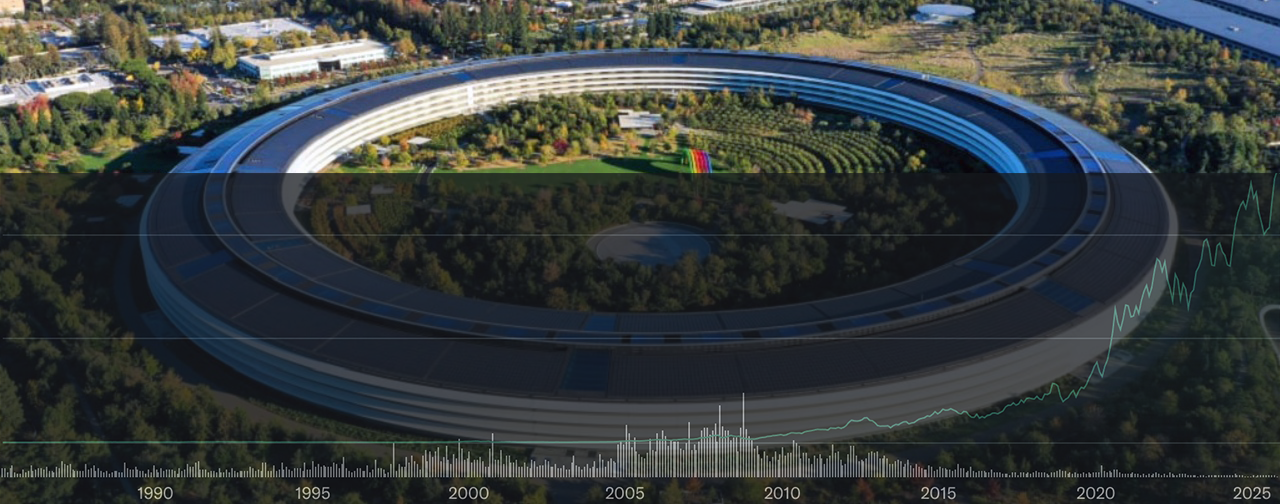Continued from this entry…
From March to the present, I’ve been on an accelerated path at putting what has been “dead” money to work. This meant rolling over my retirement holdings; 403(b) deferred compensation plan and 457(b) tax deferred annuity into a new IRA account at E*TRADE (want to keep all of this separate from my core holdings that were acquired pre-1999). This new account was immediately setup as a ROTH IRA. Additionally, I took some savings and sunk it into my Scottrade account (which is not a retirement account — it’s a regular one which allows some immediate liquidity/access, albeit with the downside being if I do sell, have to deal with capital gains tax.
Earlier, I said “dead” money, because while it has gone up big in the past, it also gave up most of it during the bursting of the tech bubble and the subsequent recession earlier in the decade. I left $10,000 in the 403(b) to see what sort of performance I could get compared to my new position in AAPL (see the end for the performance comparison at the end of 2010).
Apple the company was just getting on a roll. As it turned out, the iPhone was a huge hit even though the initial version was not subsidized, was only 2.5G (versus 3G), and there was no native application development (Apple was pushing web apps but eventually relented – that push by lower level execs to change Jobs mind was huge and opened up the door to increasing the value added aspect of the device). That modest initial goal of capturing just 1% of the global smartphone market was easily met. Once the App Store went public, Apple’s growths prospects just exploded. Even during the global financial crisis in 2008, customers still found money to purchase their iPod or iPhone. Furthermore, the high margin Mac desktop line continued experiencing growth — a result of the halo effect as non-traditional Apple customers became accustomed to the quality of the products + customer service. Generally speaking, Apple saw some of its biggest growth during a recession — which is interesting because an iPods and iPhones are not edible (i.e. discretionary spending normally is curtailed as people tend to do most of their spending on items considered necessities). Which says a bit about the sort of world we now live in — where this little piece of technology is now considered an integral and important part of many peoples daily lives.
While Apple’s earnings continued showing signs of unabated growth, the stocks P/E continued undergoing compression. Reminds me of back in the 1998-early 2000 time period when Wall Street just did not get Apple. This time around, there were various distractions including Jobs’ health issues, CEO succession plans, the law of large numbers and whether or not Apple would even be able to sustain this level of growth. As usual, very few of the analysts covering the company really could see the bigger picture early on in the game (back in the late 90’s, the analyst who saw the light of day quickly was Lou Mazzucchelli from Gerard Klauer Mattison — his current day equivalent would be Gene Munster from Piper Jaffray). Nowadays, there is a whole cadre of non-pro individuals doing their own coverage from the sidelines; and many of them have been outperforming the paid professionals when it comes to AAPL (mainly because like myself, they spend the bulk of their time covering only a few equities). One of my favorites is Horace Dediu.
As in the past, so long as the fundamentals remained intact, any weakness was the time when I’d buy (and I’d just purchase with whatever free cash I didn’t need at the time even if it was for just 5 shares). Even back in the middle of 2009 when AAPL was just a tad below $150 (after having gone through a rocky 2008 which was the best buying opportunity to take this next journey), my take was that anything below $150 would be a steal. All too often, people just focus on the share price so when they see it at a certain price, think of it as too expensive. Regardless of the share price of any equity, the bottom line is the amount of principle that each individual has to invest. If you have $1,000, well, that is all that you’d be able to afford. The total number of shares that one can purchase with that principle amount doesn’t matter. What matters is the potential return on that initial principle. Here are the purchases of AAPL I made in my non-retirement brokerage account:
In 2007, I ended up purchasing a total of 400 shares in this account. I didn’t make any more purchases on Scottrade until 2010 when the share price had gone over $200 (majority of my accumulating goes on in my ROTH IRA brokerage account). Notice that on my 2007 shares, I had already doubled my money by the time 2010 rolled around. To some, nearly $100 per share seemed too expensive at the time. Now look at the shares I bought in mid-2010. Back then, my personal end of year target was $380 (didn’t quite make it there) which represented at least a 50% upside if I bought at $250 or less. Fast forward to the start of 2012 where AAPL was now trading at $400 per share. And note that with their ongoing earnings performance, the stock should actually be much higher (if it were afforded a higher multiple to give it a valuation more representative of its earnings). Today, I can personally say for myself, that anything under $450 per share would be a steal. Even if I were to buy at $500 per share, my personal new target is $650 per share within the next 18 months (and I’m being conservative). That still represents a 30% potential upside ROI — where else can I get this kind of return?
Likewise though and as mentioned in the important disclaimer linked at the top, anyone considering getting into the market really needs to do their own homework. None of what I’m writing should be even considered advice to buy the stock. I write this stuff just to illustrate how my own personal experience has not been all positive and that one cannot expect the entire process to be easy and without occasional frustration and pain. Additionally, there are many who think my tactic is totally insane and not prudent (being overweight in an equity is one thing, being obese and almost 95% invested in a single equity is crazy by normal standards; though it should be obvious by the writing on this blog is that my view of normal is not what most others consider, normal). I’m taking my own road and listening to my inner intuition on this one. It’s almost a repeat of what occurred 10+ years earlier, but this time around, I’m sticking to my plan and living/dying by it even though most do not not think this is wise or prudent. Again as mentioned in previous postings, no guts, no glory. Or maybe, stupid is, as stupid does. And I’m posting this stuff public now where it is out there for anyone to see what happens down the road, and whether my own decisions were correct or not.
As of this entry, AAPL has blasted through several points of resistance to the upside and revealed an all new intraday high ($526). As in the past, I know exactly where my purchase points will be on the inevitable pull back that will occur. There are also several gaps which usually tends to get filled (one of those is all the way back down to the $430 level). Technical trading usually becomes a self-fulling prophesy but I’m not even playing for the $430. As mentioned earlier, I now just look at anything below $450 as a steal because what I do know is this for 2012. iPad 3, the next iPhone, iPod revisions, revisions to the Mac hardware line, potential announcements of the next version of Mac OS X and iOS this summer at WWDC. People thought the iPhone 4S numbers were through the roof… the next version will likely be a major revision and will likely put the 4S numbers to shame. The unknown factor however is what is going to be the driver for potential new sources of revenue and growth (of the ecosystem). And best of all, the fundamentals surrounding the company is still intact. They aren’t doing anything stupid or crazy and are still acting like they are a startup. It’s for all these reasons why I remain extremely bullish and continuing on this path of going “all in”.
Finally, going back to how my diversified portfolio did compared to what I had invested in my new AAPL position. At the end of 2010, the $10k I had left in my 403(b) stood at $6,437. The majority of the loss came during the 2008 global financial crisis when it dipped all the way to $5,200. For just the 2007 AAPL shares purchased, those were up 266%. Uhm, yeah, diversification worked out really well… I’m not saying diversification is wrong or bad — my point is related to what I’m doing where I’m using what knowledge and understanding I have to make the most potential gains within very specific time frames.




